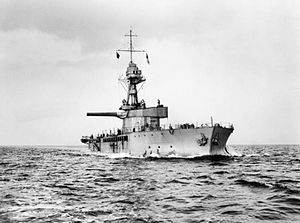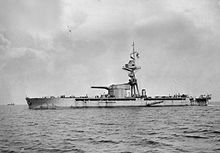- Marshal Ney class monitor
-

HMS Marshal Ney with guns trained to starboardClass overview Name: Marshal Ney Builders: Palmers Shipbuilding and Iron Company Operators:  Royal Navy
Royal NavyIn service: 1915 - 1957 In commission: 1915 Completed: Two General characteristics (Ney and Soult[1]) Type: Monitor Displacement: 6,670 tons (Standard)
6,900 tons (Full load)Length: 355 ft (108 m) Beam: 90 ft (27 m) Draught: 10 ft 5 in (3.18 m) Propulsion: Diesel engines (MAN for Ney, Vickers for Soult), 2 shafts, 1,500 hp Speed: 9 knots (17 km/h) designed
6 knots (11 km/h) best actualComplement: 187 Armament: 2 × 15-inch main guns in a single turret
8 × 4-inch guns
2 × single mount 3 inch (76 mm) guns
2 × 12-pounder gunsArmour: Turret: 13 inch
Barbette: 8 inch
Belt: 4 inchThe two Marshal Ney class monitors were built for the Royal Navy during the First World War
Contents
Design and development
The need for monitors for shelling enemy positions from the English Channel had become apparent only at the start of the war and they were designed with some haste. The design of monitors had been given by the Director of Naval Construction (DNC), Eustace Tennyson d'Eyncourt, to the Assistant Constructor, Charles S. Lillicrap (later himself to become DNC). By the time the Marshal Neys came about some 33 monitors of various sorts had already been ordered. The redesign of HMS Renown and Repulse meant that there were now two modern 15-inch turrets available. The First Sea Lord Jackie Fisher and Winston Churchill, First Lord of the Admiralty decided these should be used for two more monitors, initially M 13 and M 14, but then renamed after the French Napoleonic War marshals Nicolas Jean de Dieu Soult and Michel Ney.
For machinery the two monitors received diesel engines, which were then a novelty - the majority of ships being steam powered. The use of diesels meant that they had no need of boiler rooms which went well with a low draught nor large funnels which reduced the amount of superstructure. These engines were originally designed for much smaller freighters and therefore they proved particularly slow and unreliable.
The turret was on multi-sided barbette made of individual flat plates, cutting down on the build time. The 4-inch (102 mm) guns were disposed along her sides for protection from smaller vessels, the 3-inch (76 mm) guns being for anti-aircraft use.
Ships
- built by Palmers, Newcastle
- Launched June 1915
- Completed August 1915
- Served with the Dover Monitor Squadron, after the war became a gunnery training ship. At the start of the Second World War she was considered for recommissioning but instead her turret was removed for a new monitor, Abercrombie
and she became a headquarters ship. She was paid off and scrapped in 1946
- Built by Palmers, Newcastle
- Launched August 1915
- Completed November 1915
- After trials the turret was removed for HMS Erebus and she was regunned with 6- and 4-inch (102 mm) guns and acted as a guardship until the end of the war. She later acted as a depot ship gaining onshore buildings, and was renamed Alaunia II and was only finally scrapped in 1957
See also
 Media related to Marshal Ney class monitor at Wikimedia Commons
Media related to Marshal Ney class monitor at Wikimedia CommonsNotes and references
- ^ Conway, All The World's Fighting Ships 1906-1921
Marshal Ney-class monitorPreceded by: Lord Clive class · Followed by: Gorgon class
List of monitors of the Royal NavyCategories:- Monitor classes
- Marshal Ney class monitors
Wikimedia Foundation. 2010.

